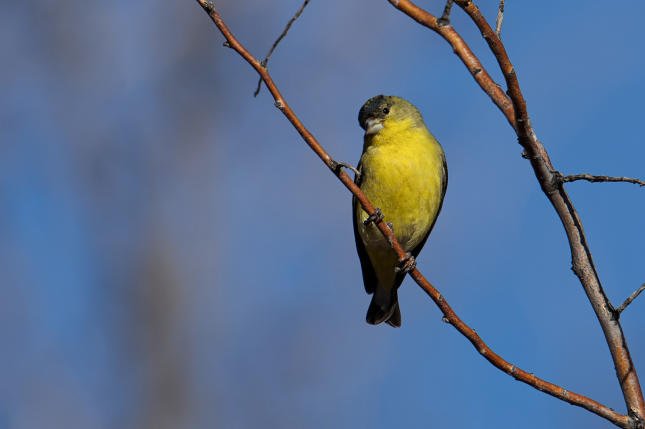
Lesser Goldfinch posing by a photo made by customer John Wright.
AUGUST WINGS - GOLDFINCH HAPPENINGS
I was recently asked what my favorite bird is. A question that, for me, changes by the day (or even the hour) when I’m out birding. This time, it was Ean, our fearless leader at WBU East, who posed the question. I paused, thought for a moment and finally answered: “Today, it’s the Lesser Goldfinch.” These birds win me over with their cheerful songs, lively feeding style, and the playful squabbles they get into at my backyard feeder. I especially love watching them cling to the mesh feeder, hopping about as they search for the perfect seed. If you’ve spotted a flash of lemon-yellow darting through your feeding station accompanied by a light, chattering song, chances are you’ve welcomed Lesser Goldfinches.
Adult males sport a bright yellow underside and a black cap and back, while females wear softer olive tones. Males are the main singers and can sing almost nonstop during their breeding season. They often weave bits of other birds’ songs into their own and are often seen traveling in loose flocks or in pairs.
Unlike the many songbirds that wrap up nesting by mid-summer, Lesser Goldfinches are late nesters going well into August. You may see them gathering nesting material or feeding fledglings at your finch feeders and on native plants. Their nesting is timed with the availability of native seeds especially sunflowers and thistles. At feeders, they love Nyjer® and sunflower chips, both excellent high-protein options supporting their energy needs. Providing a clean feeder stocked with these foods can help attract and support goldfinches as they raise their young.
It's important to sanitize your feeders to prevent the spread of disease as finches feed in groups. A quick rinse every few days and a deeper clean weekly can go a long way in keeping your backyard flock healthy. Native plants, water sources, and safe feeding spots not only help these cheerful little finches raise their young but also create a thriving habitat for many other backyard birds. Let native plants and wildflowers go to seed. These plants provide natural food, cover, and nesting material all in one.
- Avoid deadheading! Let seed heads dry and remain on the plant.
- Avoid using herbicides and pesticides to keep your yard bird-friendly.
- Add a Nyjer® feeder near a water source to supplement natural food sources.
- Provide a water source. A birdbath with moving water helps.
Visit Wild Birds Unlimited Albuquerque East for fresh Nyjer seed, finch feeders, and expert advice to help you enjoy the Lesser Goldfinch’s presence all season long. Ask for Ean and let him know what your favorite bird is or email us at [email protected]. Connect with us on social media for more tips and happenings: WBUABQ on Instagram, Wild Birds Unlimited (Albuquerque, NM East) on Facebook and our YouTube Channel - WildBirdsUnlimitedABQEast.
Thank you,
PD StClair, WBU Staff Member

